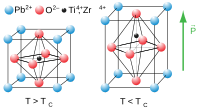
Photo from wikipedia
Abstract In this work, bismuth (Bi) and copper (Cu) doped lead lanthanum zirconate titanate (PLZT) 9/65/35 ceramics were fabricated by solid state sintering. Measurement of dielectric and ferroelectric properties at… Click to show full abstract
Abstract In this work, bismuth (Bi) and copper (Cu) doped lead lanthanum zirconate titanate (PLZT) 9/65/35 ceramics were fabricated by solid state sintering. Measurement of dielectric and ferroelectric properties at various temperatures was performed to determine electrocaloric effect in the ceramics. It was found that both undoped and doped PLZT ceramics exhibited relaxor behavior and phase transition from ferroelectric to relaxor. Indirect measurement of electrocaloric effect revealed that pure PLZT had broad peak of temperature change around the temperature at maximum dielectric constant and doped PLZT had narrower peak. Temperature change resulting from electrocaloric effect due to phase transition at low electric field could be observed in co-doped PLZT. It can be concluded that compositional effect played an important role to the change of dielectric, ferroelectric and electrocaloric properties because doping caused the change of electronic structure from A- and B-site substitution in perovskite structure of PLZT and the change of dynamic polar nanoregions.
Journal Title: Ceramics International
Year Published: 2020
Link to full text (if available)
Share on Social Media: Sign Up to like & get
recommendations!